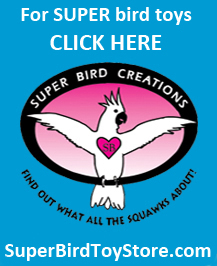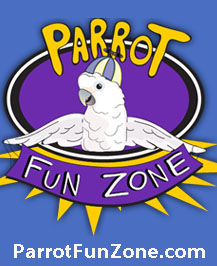 The single most important item you will ever purchase for your parrot companion is its cage. There are many factors that must be considered in making a safe and appropriate choice for your bird:
The single most important item you will ever purchase for your parrot companion is its cage. There are many factors that must be considered in making a safe and appropriate choice for your bird:
- Size
- Style
- Construction
- Bar Spacing
- Bar Orientation (horizontal/vertical)
- Ease of maintenance
- Cage Placement
Cage Size - The Bigger the Better
As humans, we seek out nature to enjoy the massive expanse of openness, beauty and the sense of freedom that it conveys. Compared to the freedom they experience in the wild, our parrots are severely restricted in captivity. A cage is your bird's primary environment and it is of the utmost importance that they be able to move freely, flap their wings, climb, play, do acrobatics, forage and perch at multiple levels within that environment. Keeping your bird in a cage that doesn't allow for participation in these activities will be detrimental to the physical and mental well-being of your companion and may lead to the development of stereotypical behaviors such as screaming, feather plucking and aggressiveness. Therefore, the first rule when choosing a cage is to buy the largest possible cage that you can afford from both a space and financial perspective.
Please refer to our handy Cage Size Guide for species specific cage size recommendations.
Style Considerations
Cages should be purchased with functionality and safety taking precedence over eye appeal. Fortunately, there are cage manufacturers who are combining the best of both worlds by making safe, functional and attractive cages. There are many choices when it comes to cage style. Here are a few important considerations to ponder:
Cages come in a variety of shapes from rectangular to round. Although round cages may be attractive, they really cut down on available living space for your bird and as such aren't recommended.
Again, size matters. Be sure to choose a cage that offers as much horizontal and vertical space as possible. Small birds such as finches and budgies need a large horizontal cage where they may fly from one side to another. Large parrots like the Macaws and Cockatoos need a large vertical cage so they may climb up the bars but they should also be wide enough to allow for wing flapping.
Dome Top cages provide more space for your bird to climb and play. They also allow for easier placement of toys and perches within the cage.
Play Top Cages have a built-in play area on the top of the cage which provides an alternate space for your bird to hang out under supervision.
The best of both worlds can be achieved by the purchase of a dome top cage and a separate play gym that is portable to different rooms in the house so that your bird can participate in all aspects of family life.
There are a few functions that should be considered relative to cage openings:
-
- Do the cage doors allow for easy removal of your bird and cleaning?
- Does the door configuration allow for cage access while at the same time prevent the bird from escaping?
- Are the food bowls accessible from the outside of the cage?
Bar Spacing & Orientation
Bar spacing is an important safety consideration when to choosing a suitable cage. Your parrot should not be able to put its head through and get wedged in the space between the bars. Additionally, the diameter and strength of each bar should be large enough to ensure that the bars can not be bent or broken by your bird.
A combination of vertical and horizontal bars will help to facilitate climbing and allow for more options when hanging toy accessories in the cage.
Please refer to our Cage Size Guide for recommendations as to species specific bar spacing.
Safe Construction
Sturdiness and durability are key factors in ensuring your bird will have a long lasting and secure environment. Cages are made out of a variety of materials each with pros and cons and varied lifetimes.
Metal is the most durable of the materials commonly used. Metal cages are typically powder-coated iron or they are made from stainless steel.
Powder coated cages come in a variety of fashionable colors and are less expensive than Stainless Steel.
Stainless steel is the safest, most durable, toxic-free, easiest to clean cage material available. If you can afford a stainless steel cage, it will be the best cage investment you can make.
Acrylic cages may allow for an enhanced view of your bird but, it is reported, that they are not as durable as metal bar cages and they offer restricted opportunities for climbing.
Wood cages are most often used for smaller, non-destructive bird species (i.e., finches, canaries). Wood cages are difficult to clean and definitely not recommended for hookbills who will ultimately chew their way out of the cage.
New cages should be inspected thoroughly to ensure that they do not present any hazards that will endanger your bird as follows:
- Check all sides, connections, and fasteners.
- Are there loose parts or accessible parts that a mechanically inclined bird can disassemble?
- Are the seams well-fitting?
- Are the welds smooth and rust free?
- Are the bars and welds strong enough for your bird?
- Is the powder coat flaking?
- Is the cage top securely fastened to the frame?
- Are the locks and or latches adequate to contain your bird and prevent escapes?
- Do the perches fit securely?
- Can the bird escape when the tray is removed?
Ease of Maintenance
Nobody has perfected the self cleaning cage yet, but, there are many factors that will make your job easier:
- Stainless steel cages are the easiest to clean and they will never chip or rust.
- Trays need to be easy to remove and clean. The litter tray should be far enough below the grate to prevent birds from reaching down with their feet to grab food items that may have fallen and become spoiled or contaminated by droppings.
- Seed Guards help to reduce the mess inevitably created on your floor by tossed food, empty seed hulls, molted feathers and chewed up toys by deflecting these tossed items back into the cage bottom.
- Grates on cages for large birds should be easy to remove for cleaning but should also have a locking feature to prevent them from being pushed out by an escape artist.
- Food dishes for large birds should be accessible from the outside of the cage. Many cages now incorporate this important feature. Stainless steel or ceramic bowls will be the easiest to clean and disinfect.
- Casters will allow you to move a heavy cage more easily away from the wall to allow for cleaning.
- Storage space is often incorporated into cages in the form of a base cabinet or a simple shelf below the cage. This provides a great spot to store food, toys, newspapers, cage covers and cage cleaning supplies.
 Just as exposure to sunlight is important to your bird's health, so is exposure to darkness. This is essential to their ability to get a restful night's sleep.
Just as exposure to sunlight is important to your bird's health, so is exposure to darkness. This is essential to their ability to get a restful night's sleep. 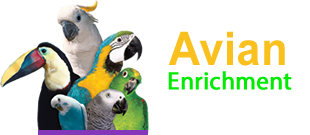

 In the wild, parrots live and breathe in fresh air and they are not exposed to the types and levels of toxins present in our homes. Indoor air pollution is a major concern for all of us and even more of a concern for our birds. The air that surrounds us daily contains many allergens, pollens, molds, fungi, pollutants and dust. Our air tight, energy efficient homes just don't allow many of these indoor pollutants to escape. The conditions worsen when the weather is cold and we are unable to circulate fresh air from a source like a cracked window.
In the wild, parrots live and breathe in fresh air and they are not exposed to the types and levels of toxins present in our homes. Indoor air pollution is a major concern for all of us and even more of a concern for our birds. The air that surrounds us daily contains many allergens, pollens, molds, fungi, pollutants and dust. Our air tight, energy efficient homes just don't allow many of these indoor pollutants to escape. The conditions worsen when the weather is cold and we are unable to circulate fresh air from a source like a cracked window. 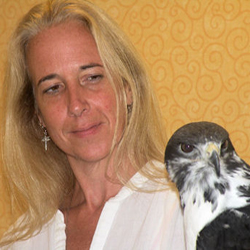 A
A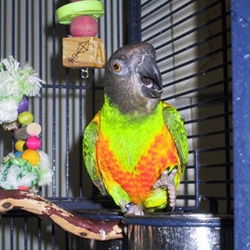 In the wild, a bird gets to choose when and where to perch, sleep and forage and they always choose locations where they feel safe and secure. Parrots are prey animals and instinctually on alert for predators at all times. A caged bird doesn't have the opportunity to decide most of this and, when they are scared, they don't have a flight option. Your parrot companion should feel secure and safe in its home and the choice of location for their cage is important for your parrot’s overall mental health.
In the wild, a bird gets to choose when and where to perch, sleep and forage and they always choose locations where they feel safe and secure. Parrots are prey animals and instinctually on alert for predators at all times. A caged bird doesn't have the opportunity to decide most of this and, when they are scared, they don't have a flight option. Your parrot companion should feel secure and safe in its home and the choice of location for their cage is important for your parrot’s overall mental health. The single most important item you will ever purchase for your parrot companion is its cage. There are many factors that must be considered in making a safe and appropriate choice for your bird:
The single most important item you will ever purchase for your parrot companion is its cage. There are many factors that must be considered in making a safe and appropriate choice for your bird: Birds in the wild are encircled by an amazingly vast, beautiful and always changing environment that is also full of challenge, opportunity, risk and reward.
Birds in the wild are encircled by an amazingly vast, beautiful and always changing environment that is also full of challenge, opportunity, risk and reward. 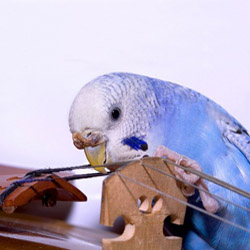 In the wild, there is a continuous background of nature sounds; birds vocalizing, insects buzzing, leaves rustling in the wind, raindrops, etc. Birds living within the confines of our sound proof homes live in relative silence. Silence in the wild is usually a warning signal, indicating the presence of a predator.
In the wild, there is a continuous background of nature sounds; birds vocalizing, insects buzzing, leaves rustling in the wind, raindrops, etc. Birds living within the confines of our sound proof homes live in relative silence. Silence in the wild is usually a warning signal, indicating the presence of a predator.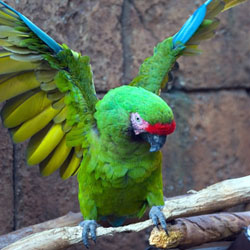 Your bird is on their feet 24/7. In the wild, they have a multitude of choices of where to perch and can fly from branch to branch giving their feet and legs exercise. In nature, parrots are also exposed to branches of various sizes, widths, and orientations. The perches in your bird’s cage should mimic these natural conditions as much as possible.
Your bird is on their feet 24/7. In the wild, they have a multitude of choices of where to perch and can fly from branch to branch giving their feet and legs exercise. In nature, parrots are also exposed to branches of various sizes, widths, and orientations. The perches in your bird’s cage should mimic these natural conditions as much as possible.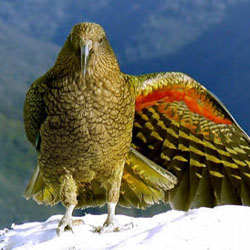 The winter months are upon us and they present some unique challenges when it comes to keeping our birds healthy and safe. The colder temperatures, lower humidity and shorter days of winter can all negatively impact our bird's health.
The winter months are upon us and they present some unique challenges when it comes to keeping our birds healthy and safe. The colder temperatures, lower humidity and shorter days of winter can all negatively impact our bird's health.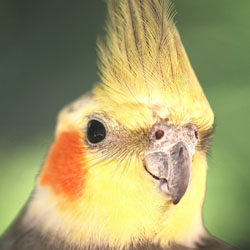 In the wild, parrots live in the tropics and subtropics where they are exposed, every day, to very humid conditions. Humidity is important for healthy skin and feathers. The lack of humidity can result in dry flaky and itchy skin which will irritate your parrot companion and can lead to feather plucking.
In the wild, parrots live in the tropics and subtropics where they are exposed, every day, to very humid conditions. Humidity is important for healthy skin and feathers. The lack of humidity can result in dry flaky and itchy skin which will irritate your parrot companion and can lead to feather plucking.